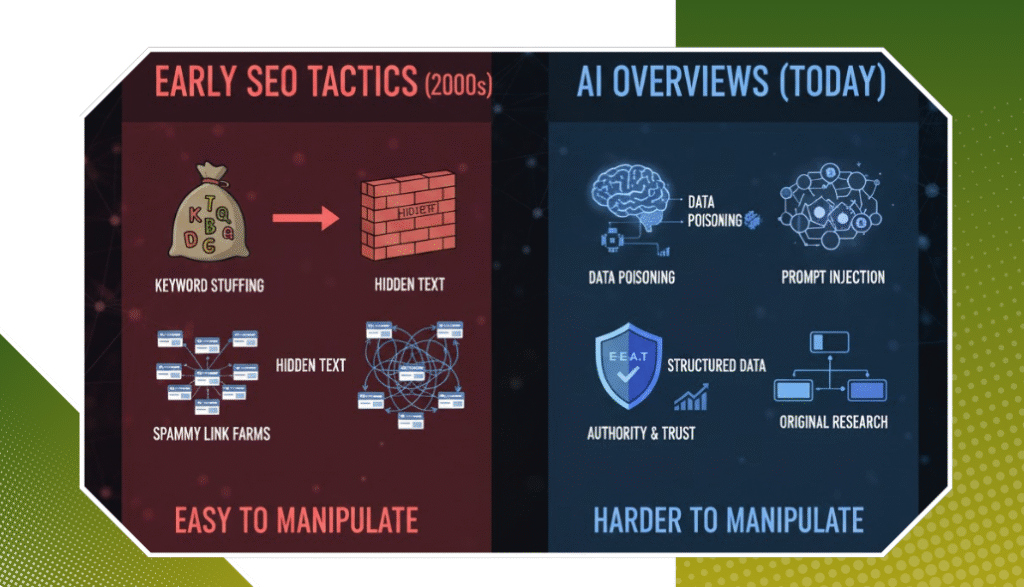For site owners, SEOs, and marketers, being cited in an AI Overview can drive visibility, traffic, and brand credibility. But how exactly does Google decide which sources deserve that placement? In this blog, we break down the key factors behind citation selection in AI Overviews, drawing from Google documentation, SEO best practices, and current industry observations.
What Is an AI Overview on Google Search?
AI Overviews are AI-generated summaries that appear at the top of Google Search for specific queries. They synthesise information from multiple web sources to provide quick, helpful responses to user questions. This feature is currently part of Google Search Labs and is being rolled out more broadly in 2024.
Unlike featured snippets, which quote a single source verbatim, AI Overviews are more dynamic. They combine information across several web pages and cite relevant sources beneath the AI-generated content. Each citation functions as a clickable link, allowing users to verify information and explore more in-depth content.
How Google Selects Sources for AI Overviews
Google uses its traditional ranking signals in tandem with new AI-based quality evaluations to determine which sites to cite in an AI Overview. The following are critical factors:
Content Relevance
Google prioritises content that directly addresses the search query in a clear and meaningful way. The AI model is trained to identify topical alignment between the query and web page content.
Expertise and Authoritativeness
Sites that display deep expertise on a topic are more likely to be selected. This aligns with Google’s E-E-A-T principles: Experience, Expertise, Authoritativeness, and Trustworthiness. For example, a health-related query is more likely to cite content from Mayo Clinic or WebMD than a general blog.
Content Freshness and Accuracy
Google’s AI prefers up-to-date, accurate content. Stale or outdated information is less likely to be used. Regularly updating your website and referencing current data improves the chances of citation.
Content Quality Signals
Google’s systems evaluate the overall quality of a page, including depth of information, clarity, and grammar. Well-structured content that’s easy to parse gives the AI system a better chance of extracting useful information for citation.
SEO and Technical Signals That Influence Citation
While content remains king, technical SEO plays a foundational role in ensuring that your site is even eligible to be cited.
- Page Load Speed & Mobile-Friendliness: Google prefers fast-loading, mobile-responsive websites. A slow site may not be crawled effectively or considered reliable for citation purposes.
- Structured Data and Schema Markup: Using schema markup helps search engines understand your content more accurately. For example, marking FAQs or medical content with structured data improves its interpretability for AI systems.
- Crawlability and Indexing: Pages must be crawlable and indexable by Google to appear in search results and AI Overviews. Ensure there are no robots.txt restrictions or noindex tags blocking access to key pages.
- Strong Internal Linking: Logical internal linking structures boost topical authority and signal content relevance to Google’s crawlers. This can enhance your visibility not just in traditional search but in AI-generated summaries.
Content Qualities That Get Cited
Not all well-optimised pages make it into an AI Overview. The content itself must be designed to meet the needs of both users and AI-driven systems.
- Clear, Concise Answers: Pages that provide straightforward, informative answers within the first few paragraphs are more likely to be cited. Bullet points, tables, and short summaries increase clarity.
- Originality and Insight: Google’s AI favours original insights over regurgitated content. Adding unique data, firsthand experience, or expert commentary enhances your content’s value.
- Organised Formatting: Using proper header hierarchy (H2, H3), short paragraphs, and lists makes it easier for AI systems to extract key points. This also improves the overall user experience.
Is Domain Authority a Factor?
Domain Authority (DA) is a third-party metric from Moz, not a direct ranking factor used by Google. However, it does reflect some real-world trust indicators, such as backlink quality and domain age. What Google actually values is the demonstrated trustworthiness and relevance of a site based on:
- Quality backlinks from authoritative sources
- Topical depth and coverage
- Real-world reputation (such as mentions on news sites, academic papers, etc.)
Thus, a high-DA site might get cited more often, but smaller niche websites with strong topical authority can also appear in Google’s AI Overview.
Can You Optimise for AI Overview Inclusion?
Yes, but it requires a refined content and AI SEO strategy. This means going beyond traditional keyword stuffing and focusing on how your content can assist generative AI systems in forming coherent, accurate responses.
1. Focus on User Intent
Understand the exact need behind a search query. Align your content structure and headings to reflect the intended purpose.
2. Build Topic Clusters
Create clusters of interlinked pages around core topics to boost semantic relevance. This not only helps with regular SEO but also supports your AI SEO strategy by establishing depth in subject matter.
3. Use Natural, Conversational Language
AI-generated responses often mimic conversational tone. Your content should do the same while maintaining factual accuracy. This approach fits naturally into Google’s AI Overview model.
4. Monitor Google’s AI Overview Trends
Use tools like Search Labs and SEO platforms that track AI Overview appearances. Analyse what types of pages are cited for your target keywords and reverse-engineer their structure and tone.
5. Avoid Over-Optimisation
While it’s essential to employ SEO practices, stuffing keywords or using unnatural language can compromise the clarity of your content and diminish its chances of being cited. An effective AI SEO strategy is about context, structure, and relevance, not just keywords.
Examples: Sites Commonly Cited in AI Overviews
Observational data suggests that Google tends to cite:
- Government and educational institutions (like CDC.gov, NIH.gov, Harvard.edu)
- Niche authoritative blogs or websites with consistent, high-quality content
- Product manufacturers or service providers with in-depth, original content (especially for YMYL queries: Your Money, Your Life)
For example, for a query like “best sunscreen ingredients for sensitive skin,” AI Overviews often cite content from dermatologist-backed skincare blogs, health organisations, or ingredient databases.
Conclusion
Getting cited in a Google AI Overview is both an opportunity and a challenge. While the selection process is not fully transparent, it follows many of the same principles that govern traditional organic rankings: quality content, strong SEO fundamentals, and apparent topical authority.
As Google’s generative search evolves, the best approach is to focus on producing trustworthy, helpful content that directly serves the user’s intent. Aligning your site with these goals not only improves your chances of being cited in an AI Overview but also supports long-term SEO performance across all types of search results.




